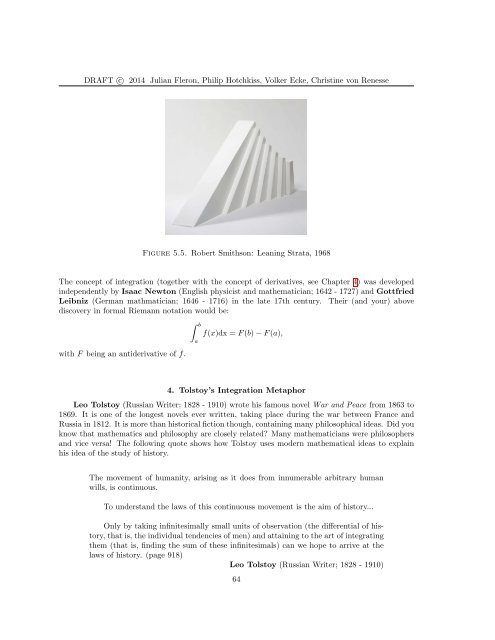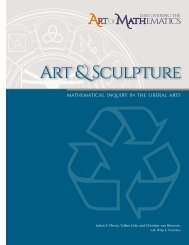calculus-2014-05-21
calculus-2014-05-21
calculus-2014-05-21
Create successful ePaper yourself
Turn your PDF publications into a flip-book with our unique Google optimized e-Paper software.
DRAFT c○ <strong>2014</strong> Julian Fleron, Philip Hotchkiss, Volker Ecke, Christine von Renesse<br />
Figure 5.5. Robert Smithson: Leaning Strata, 1968<br />
The concept of integration (together with the concept of derivatives, see Chapter 4) was developed<br />
independently by Isaac Newton (English physicist and mathematician; 1642 - 1727) and Gottfried<br />
Leibniz (German mathmatician; 1646 - 1716) in the late 17th century. Their (and your) above<br />
discovery in formal Riemann notation would be:<br />
with F being an antiderivative of f.<br />
∫ b<br />
a<br />
f(x)dx = F (b) − F (a),<br />
4. Tolstoy’s Integration Metaphor<br />
Leo Tolstoy (Russian Writer; 1828 - 1910) wrote his famous novel War and Peace from 1863 to<br />
1869. It is one of the longest novels ever written, taking place during the war between France and<br />
Russia in 1812. It is more than historical fiction though, containing many philosophical ideas. Did you<br />
know that mathematics and philosophy are closely related? Many mathematicians were philosophers<br />
and vice versa! The following quote shows how Tolstoy uses modern mathematical ideas to explain<br />
his idea of the study of history.<br />
The movement of humanity, arising as it does from innumerable arbitrary human<br />
wills, is continuous.<br />
To understand the laws of this continuouss movement is the aim of history...<br />
Only by taking infinitesimally small units of observation (the differential of history,<br />
that is, the individual tendencies of men) and attaining to the art of integrating<br />
them (that is, finding the sum of these infinitesimals) can we hope to arrive at the<br />
laws of history. (page 918)<br />
Leo Tolstoy (Russian Writer; 1828 - 1910)<br />
64



